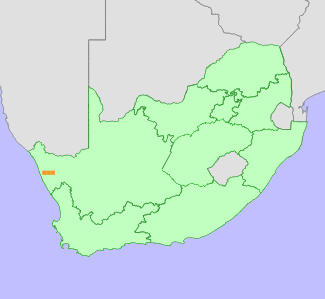|
Scientific Name | Conophytum auriflorum Tischer subsp. auriflorum |
Higher Classification | Dicotyledons |
Family | AIZOACEAE |
National Status |
Status and Criteria | Endangered A3d+4c; B1ab(iii)+2ab(iii) |
Assessment Date | 2021/11/09 |
Assessor(s) | A.J. Young, P.G. Desmet, D. Guo, L. Jabar, L. Knoetze, C. Rodgerson, P.C.V. Van Wyk & N.N. Mhlongo |
Justification | This succulent is endemic to the Northern Cape province of South Africa occurring at only two locations with an extent of occurrence (EOO) of 268 km² and area of occupancy (AOO) of 48 km². The dwarf succulents that comprise this genus have been increasingly targeted by illegal collection in recent years and the vast majority of species are in high demand by collectors. Whilst there is no evidence of illegal collection at the time of this submission, closely related species, including some from the immediate area, have been illegally removed from habitat with a dramatic increase in the number of species and volume of plants targeted since 2019. The threat of illegal collection is therefore regarded as high for this particular taxon and a decline of up to 75% of the population is likely within the next three generations (90 years). The inability of species in this genus to disperse also makes the species very susceptible to the deleterious effects of climate change. Loss of vegetation cover has been observed across its range via Landsat imagery between 1984 and 2018 and is used to infer that the habitat quality is already in decline. Climate models for this taxon indicate a loss of 73% of suitable bio-climatic habitat by 2080 under likely CO2 emission scenarios (RCP 2.6). It therefore qualifies as Endangered under criteria A3+4 and B1+2. |
Distribution |
Endemism | South African endemic |
Provincial distribution | Northern Cape |
Range | This taxon is restricted to a small area of the winter rainfall region of the Northern Cape province of South Africa. |
Habitat and Ecology |
Major system | Terrestrial |
Major habitats | Namaqualand Klipkoppe Shrubland |
Description | This taxon is endemic to the Namaqualand Hardeveld bioregion of the Succulent Karoo biome, where it is found on Namaqualand Klipkoppe Shrubland. The plants occur in great abundance on, usually flat, patches of quartzite grit. They grow in full sun and in partial shade of rocks and small shrubs. This succulent has a generation length of 30 years. It is expected to be sensitive to the impacts of climate change as it does not disperse and while adapted to arid conditions, is dependent on limited seasonal rainfall. Species in the genus are sensitive to long periods of drought. Drought related mortality has been observed for other closely related taxa within the genus. |
Threats |
| Species across this genus are increasingly popular in cultivation. While there is no evidence that this particular taxon has been threatened by illegal collection it is very likely that it will become a target in the near future. The only known locations for this taxon are close to habitation and other related species in this area have been subject to substantial levels of poaching since 2019. A decline of 50-75% of the population is suspected over three generations. The plants are additionally threatened by livestock grazing degrading their habitat.
There is an inferred decline in habitat quality for this succulent based on the loss of vegetation cover determined from changes in Enhanced Vegetation Index (EVI) between 1984 and 2018 using Landsat data (Venter et al. 2020). Anthropogenic climate change is a long-term threat to this taxon. Climate models for the likely emission scenarios where emissions stay at present day levels (RCP 2.6) (Hausfather and Peters 2020) and worst case scenarios where emissions continue to increase during the 21st century (RCP 8.5) indicate that there will be a loss of suitable bioclimatic envelope of between 73% and 100% by 2080 for this succulent. Species in this genus have limited dispersal ability and migration to suitable habitats elsewhere is regarded as highly unlikely. |
Population |
No formal estimation of population size exists for this taxon but it is likely to be in the thousands and probably well in excess of 10,000 mature individuals. The number of plants in this general area have been in decline in recent years due to an extended drought and the population is believed to be in decline.
|
Population trend | Unknown |
Assessment History |
Taxon assessed |
Status and Criteria |
Citation/Red List version | | Conophytum auriflorum Tischer subsp. auriflorum | Rare | Raimondo et al. (2009) | | Conophytum auriflorum Tischer subsp. auriflorum | Lower Risk - Near Threatened | Victor (2002) | | Conophytum auriflorum Tischer subsp. auriflorum | Rare | Hilton-Taylor (1996) | |
Bibliography |
Hammer, S. 2002. Dumpling and his wife: New view of the genus Conophytum. EAE Creative Colour, Norwich.
Hammer, S.A. 1993. The genus Conophytum: A conograph. Succulent Plant Publications, Pretoria.
Hausfather, Z. and Peters, G.P. 2020. Emissions - the 'business as usual' story is misleading. Nature 577(618-620).
|
Citation |
| Young, A.J., Desmet, P.G., Guo, D., Jabar, L., Knoetze, L., Rodgerson, C., Van Wyk, P.C.V. & Mhlongo, N.N. 2021. Conophytum auriflorum Tischer subsp. auriflorum. National Assessment: Red List of South African Plants version 2024.1. Accessed on 2025/11/28 |
 Comment on this assessment
Comment on this assessment


